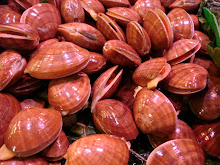This recipe is actually very closely derived from a medieval recipe. I really enjoyed this one because of its historical context, and it didn't hurt that the dish tasted something like how I would imagine an Italian black mole sauce. In the pre-refrigeration era, meat was not always fresh, and so many cooking techniques centered around hiding any rancidness in the meat and making it as safe to eat as possible. As a result the recipes from the medieval and renaissance eras often involved long, slow cooking and a lot of different spices and aromatics to help. Also note the candied fruit, another luxury item that would have been used to preserve summer's sweet treats throughout the year. This is a wonderful dish to have just as the weather begins to turn. (well in theory, not here in Florence! Its roasting, no pun intended*)
One side note before launching into the recipe. There is one small way in which the recipe has been updated in the last millennium, and that is with the addition of tomatoes. That specific fruit didn't reach Europe until 1523 (McGee, 202), and my instructor seemed to suggest that before tomatoes the Italians might have used verjus in this recipe. Verjus is a fermented grape drink made from green (i.e. young) grapes, which you can still purchase in stores, though I've never tried it.** However it was supposed to be high in acidity and strong in flavor, blending well with other tastes, much like the tomato puree in this recipe. So if you want to be very authentic, go get a bottle of verjus for this recipe!
1 kg of beef, trussed (pot roast would be great for this, brisket, chuck, or some other braising meat. The instructor also suggested replacing it with game such as hare or boar. Not as simple a task stateside...)
500 gr. of tomato puree
2 tablespoons of tomato paste
1 red onion, diced
1 stick celery, diced
1 carrot, diced
2 cloves garlic, chopped
chopped parsley
1 cup of red wine
a few glugs of olive oil
stock or water
1 bay leaf
1 stick cinnamon
salt and pepper, to taste
to finish:
30 gr candied fruit, chopped
30 gr pine nuts
30 gr raisins
50 gr. dark chocolate
4 tablespoons of white vinegar
4 tablespoons of sugar
Sear the meat off in the olive oil and set aside. Sweat the vegetables for about 15 minutes, add the meat back in, add the wine, tomatoes, and enough broth to cover the meat about 1/3 of the way up. Add salt, pepper, bay, and cinnamon. Cook over a low flame for about 2 or 3 hours. About 10 minutes before serving, remove the meat to let rest and add the ingredients to finish the sauce. Cut the meat and serve it with a good helping of the very thick, rich sauce. Enjoy this taste of medieval Italy!
*actually, pun intended
** update: I got this one slightly wrong. Grant Achatz says: "Verjus, or 'green juice' as it is otherwise known, is the unfermented pressings from unripe wine grapes." So there you have it.
Subscribe to:
Post Comments (Atom)





No comments:
Post a Comment